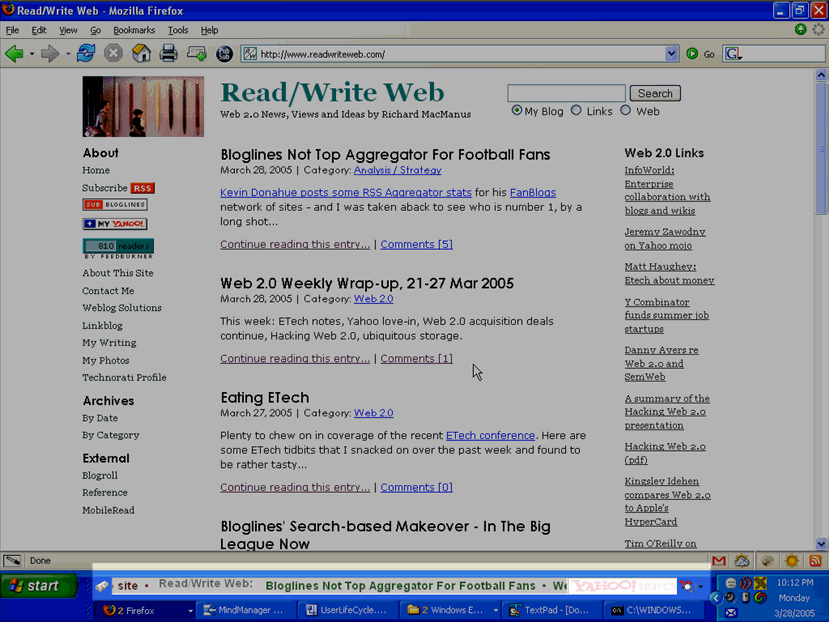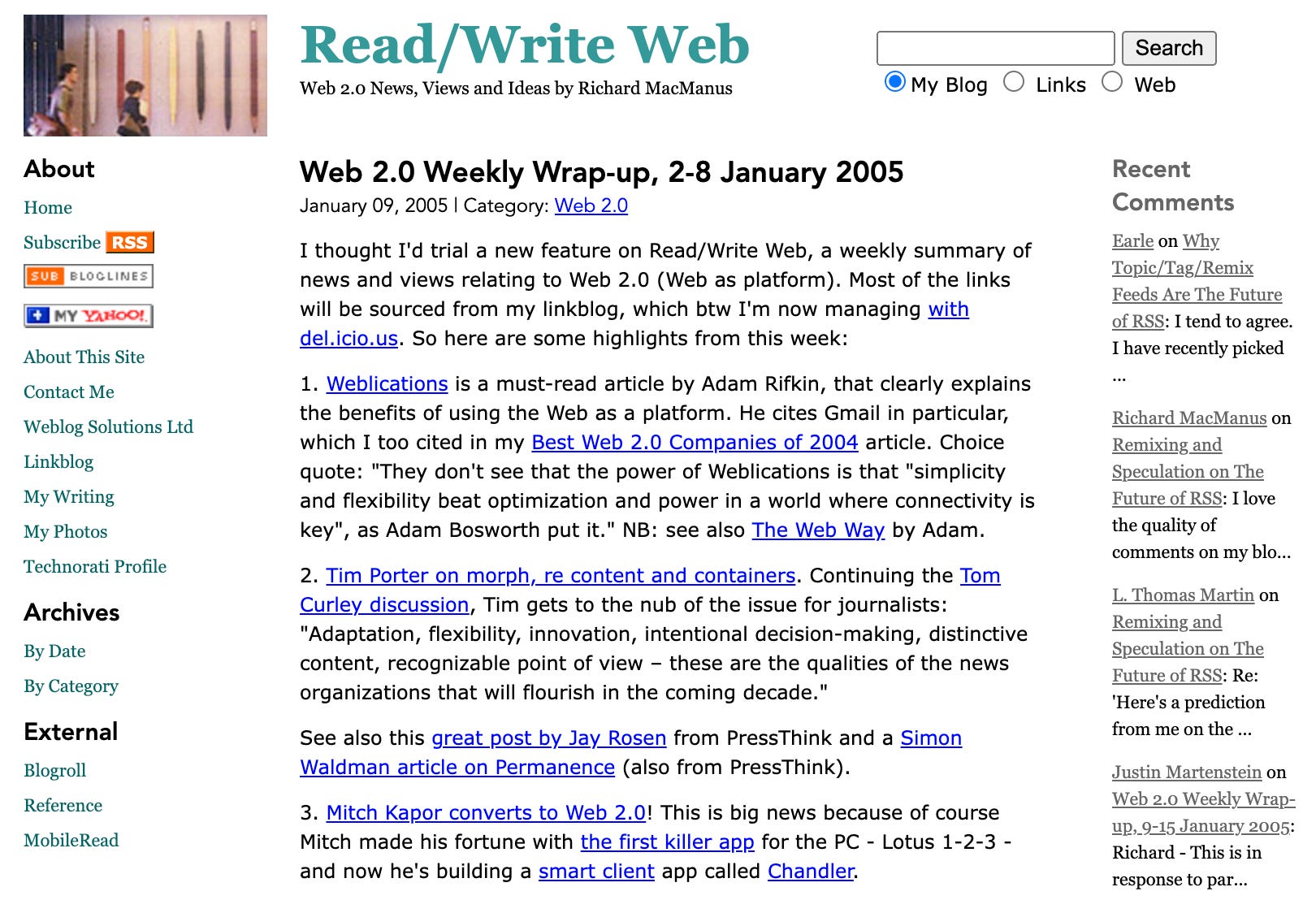Growth of Web 2.0 & RWW in 2005, Before My US Trip
I first visited the US in late September 2005. But what happened in Web 2.0 and for Read/WriteWeb in the 9 months prior?

A reader emailed me this screenshot of RWW in March 2005, in order to point out the MyYahoo Ticker at the bottom of the screen. “My RSS headlines stream on the bottom of my screen all day and I click things that catch my eye,” he told me.
Part 5 of my serialized book, Bubble Blog, describes my first trip to Silicon Valley at the end of September and for a couple of weeks in October of 2005. Some of you may’ve noticed that I skipped the previous 9 months, since part 4 was about the second half of 2004. I did that mostly because I wanted to get to my Silicon Valley experiences, which is when the action truly begins in my story. The next three sections will further describe this trip, focusing in particular on my attendance at the 2005 Web 2.0 Conference — arguably the first major tipping point for the Web 2.0 era.
However, as a bonus post for paid subscribers, I thought I’d describe how the first nine months of 2005 panned out for both Read/WriteWeb and Web 2.0 itself. I’ll be including some inside information about RWW from that timeframe — I figure, what does it matter at this point who knows about my stats etc from that era. (btw, thank you to everyone who has signed up here as a paid subscriber — your support at this early stage of my book project means a lot to me!)
Growth of ReadWriteWeb, Jan-Sep 2005
Let’s go right back to January 2005, which happened to be when I launched the Web 2.0 Weekly Wrapup. This became a long-running feature of Read/WriteWeb and helped the site become a go-to source of Web 2.0 news, which in turned increased my page views and RSS subscribers over 2005.

The first Web 2.0 Weekly Wrap-up; via Wayback Machine
Although my percentage stats growth was impressive over the year (more on that shortly), I must stress it was an extremely niche audience at that time. Here’s what I emailed someone at the beginning of April 2005:
“…page views are currently around 28-30k p/mth, which doesn’t include RSS hits of course. As for my current count of RSS subscribers: peak this week was 926 according to Feedburner (nb: Feedburner stats fluctuate during a week and drop in the weekends).”
It’s worth noting that page view counting was very unreliable in this era of the blogosphere. In fact, I discovered later (in March 2006) that Google’s Urchin — the product that would later turn into Google Analytics — was overcounting page views by perhaps five times as much as Statcounter, the app I was using over 2005. As I wrote in March 2006:
“You see recently I’ve been using Urchin (owned by Google) web stats as part of my MediaTemple web hosting arrangement, along with statcounter.com which I’ve used for years. I’ve been noticing that Urchin page view stats are MUCH higher than statcounter.com - in fact 5 times higher!”
So bear that in mind as you read this post. You may’ve seen much higher stats quoted in the past about early tech blogs, but chances are those figures were flat out wrong and misleading.
In any case, even despite the dubious page view counting of that period, I knew that my stats didn’t compare well to more mainstream tech publications, such as Boing Boing or Gawker. Furthermore, my stats paled in comparison to highly targeted sites like Darren Rowse’s digital photography blog.
But I also knew that Read/WriteWeb was a different kettle of fish than Boing Boing or a blog that reviewed digital cameras. RWW wasn’t writing about mainstream topics (like photography), and it wasn’t even mainstream in an ‘alternative’ way (like Boing Boing). Instead, I was reaching a small but highly influential audience of web entrepreneurs and developers — I knew this based on the emails I was getting and the comments on my blog.
This was around the time I was thinking about getting sponsors for my site, so I reached out to a few people for their advice. One was Rafat Ali, founder of PaidContent, who generously suggested a couple of pricing options for a site like mine.
Potential sponsors had begun to reach out to me already, in the first quarter of 2005 and into the second. I told one in early April that RWW was “not an A-List site, but because of my focus on Web 2.0 technologies and the reputation I’ve built up, any sponsorship adverts would be highly targetted to an influential audience.”
Indeed, I got my first sponsor that very month. It was an Atlanta-based startup called ThePort Network, who agreed to sponsor my Weekly Wrapup for three months. (I discuss this more in part 8 of the book, coming soon.)

My very first sponsor, ThePort Network. Not sure whatever became of it, but I’m grateful it took a chance on an indie tech blog in April 2005.
Just before I travelled over to Silicon Valley at the end of September, I sent this email to another potential sponsor. It shows that, in less than six months, my page views had more than doubled and I had 5x’ed my RSS subscribers:
“My weblog has become very popular in the last 6 months and is growing at a fast rate. It currently has around 4,700 subscribers and is averaging over 2,000 page views a day (and will likely increase during and after the conference).”
I won’t bore you with any more stats talk, but I wanted to put RWW’s growing (but still niche) popularity into some context, before we head into the rest of 2005 and into 2006 — which is when both RWW and Web 2.0 really started to pick up momentum. Part 6, to be published on Monday, continues that story.
Web 2.0 During the First 3 Quarters of 2005
Looking back on it now, the first three-quarters of 2005 was notable for some significant acquisitions and launches in the emerging Web 2.0 market. Bloglines, my favourite RSS Reader at the time, was acquired in February by Ask.com. But it was the acquisition of Flickr in March, by Yahoo, which signaled that Web 2.0 was open for business.
Other interesting acquisitions during this period included:
-
Google buying Android in July (although it would take many months before anyone even noticed);
-
News Corp buying then leading social network MySpace the same month (which, like many acquisitions, then and now, effectively ended its run of success); and
-
eBay purchasing Skype in September (notable mainly for going over the billion dollar mark, perhaps for the first time in Web 2.0).

Yahoo actively integrated RSS into its products over 2005; diagram from a Scott Gatz presentation (Scott was Yahoo’s “RSS guy”), Dec 2005.
There were also several significant launches during the first part of 2005: Google Maps in February (important for the rise of “mashups”, due to its API), Reddit in June, and the beta of YouTube in May.
I should also mention a few tech blog launches during this time: TechCrunch, of course, in June; Mashable began around July (Pete Cashmore first left a comment on RWW in September ‘05); and ProgrammableWeb by John Musser started in August. There were others, but I’ll talk more about that when I get to the Web 2.0 Workgroup I formed with Mike Arrington and Fred Oliviera in October.
Lastly, I have to mention a very influential essay that was published in February, which was inspired by the launch of Google Maps. It was by Jesse James Garrett from the web design firm Adaptive Path. The essay, “Ajax: A New Approach to Web Applications”, ushered in a new buzzword (Ajax) and popularised a form of JavaScript development where updates happened on a web page without the page needing to be reloaded. It wasn’t an entirely new technique, but it became more prevalent after Ajax was coined.

Diagram of Ajax web development by Adaptive Path
After noting that Google was using the Ajax approach in all of its recent web products — including Gmail and Maps — Garrett wrote that “many of the features that people love in Flickr depend on Ajax, and Amazon’s A9.com search engine applies similar techniques.” Along with RSS, APIs and Ruby on Rails, Ajax was among the most talked about technologies in the early part of Web 2.0.
So there you have it: the first 3/4 of 2005 were busy for both Read/WriteWeb and the trend I was focused on during that time: Web 2.0. Stay tuned for part 6 of my book on Monday, which resumes at the October 2005 Web 2.0 Conference in San Francisco.
You're reading Cybercultural, an internet history newsletter. Subscribe for free, or purchase a premium subscription. Your support for this indie publication would be greatly appreciated.